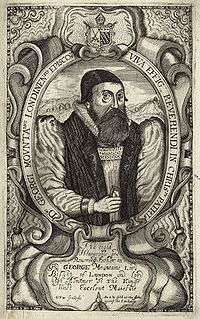George Montaigne
George Montaigne (or Mountain; 1569 – 24 October 1628) was an English bishop.
George Montaigne | |
|---|---|
| Archbishop of York | |
 George Montaigne during his time as Bishop of London. | |
| Church | Church of England |
| Diocese | York |
| Installed | July 1628 |
| Term ended | 24 October 1628 |
| Predecessor | Tobias Matthew |
| Successor | Samuel Harsnett |
| Orders | |
| Ordination | 28 June 1593 by Richard Howland |
| Consecration | 14 December 1617 by George Abbot |
| Personal details | |
| Born | 1569 Cawood, Yorkshire |
| Died | 24 October 1628 London |
| Buried | All Saints Church, Cawood |
| Nationality | English |
| Denomination | Anglican |
Ordination history of George Montaigne | |||||||||||||||||||||||||||||
|---|---|---|---|---|---|---|---|---|---|---|---|---|---|---|---|---|---|---|---|---|---|---|---|---|---|---|---|---|---|
| |||||||||||||||||||||||||||||
| Source(s): [1] | |||||||||||||||||||||||||||||
Life
Montaigne was born in 1569 at Cawood, Yorkshire.[2] He was educated at Queens' College, Cambridge, matriculating at Michaelmas 1586, graduating B.A. 1590, M.A. 1593, B.D. 1602, D.D. 1607, and holding a fellowship at Queens' 1592–1611. He was ordained deacon and priest at Peterborough in 1593.[3]
In 1597 he was chaplain to Robert Devereux, 2nd Earl of Essex, on his expedition against Cadiz. He became rector of Great Cressingham in 1602. He was Gresham College Professor of Divinity in 1607, and in 1608 Master of the Savoy and chaplain to James VI and I.[2]
He was Dean of Westminster in 1610. He was appointed Bishop of Lincoln in 1617 and was consecrated on 14 December that year by Archbishop George Abbot, and co-consecrated by the Roman Catholic Archbishop of Split Marco Antonio de Dominis. He was appointed Lord High Almoner in 1619, Bishop of London in 1621 and Bishop of Durham in 1627.[2]
When in 1628 the archbishopric of York fell vacant by the death of Tobias Matthew, Montaigne is said to have secured the nomination by remarking to Charles I, "Hadst thou faith as a grain of mustard seed, thou wouldst say unto this mountain, be removed into that sea [see]" (Matthew 17:20). He was duly elected to the archbishopric on 1 July, but died in London on 24 October 1628, and was buried in Cawood Church.[2]
He was one of the Arminian group of bishops who arose in opposition to the general Calvinism that prevailed in the Church of England in the early seventeenth century. One manifestation of his views were prosecutions in his London diocese for the disrespectful wearing of hats in services.[4]
Notes and references
- The Apostolic Succession and the Catholic Episcopate in the Christian Episcopal p. 181 (Google Books)
- Bradley, E. B. (1894). . In Lee, Sidney (ed.). Dictionary of National Biography. 38. London: Smith, Elder & Co.
- "Montaigne, George (MNTN586G)". A Cambridge Alumni Database. University of Cambridge.
- Corns, Thomas N. (2003). A Companion to Milton. p. 115.
External links
| Academic offices | ||
|---|---|---|
| Preceded by William Dakins |
Gresham Professor of Divinity 1607–1610 |
Succeeded by William Osbaldeston |
| Church of England titles | ||
| Preceded by Richard Neile |
Bishop of Lincoln 1617–1621 |
Succeeded by John Williams |
| Preceded by John King |
Bishop of London 1621–1627 |
Succeeded by William Laud |
| Preceded by Richard Neile |
Prince-Bishop of Durham 1627–1628 |
Succeeded by John Howson |
| Preceded by Tobias Matthew |
Archbishop of York 1628 |
Succeeded by Samuel Harsnett |
